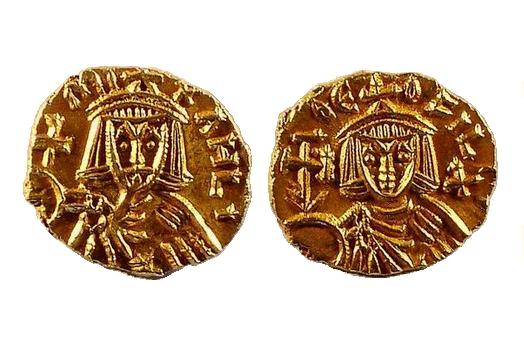
about ancient nomos
Ancient Nomos Art is a museum of galleries exhibiting ancient coins and ancient mint maps. The coin gallery displays the diverse art and history of hand-crafted ancient Greek, Roman, Byzantine, Persian and Medieval coinage. The ancient mints mapping gallery features Greek, Roman, Byzantine, Asia Minor and Medieval mint city regions and territories. Visitor's are welcome to explore, study and enjoy Ancient Nomos Art.

Byzantine, Roman – 821 AD
Michael II
From Ancient Galleries

Obverse: Crowned Michael II facing, wearing chlamys, holding globus cruciger.
Reverse: Crowned Theophilus wearing chlamys, holding cross potent on globus.
LEGEND
Obv. *MIXAHL b, Crowned facing bust of Michael II (the Amorian), wearing chlamys, holding globus cruciger. Rev. ΘE O FILOS, Crowned facing bust of Theophilus, wearing chlamys, holding cross potent on globus; cross to right.
Following the brutal murder of Emperor Leo V in 813 AD on Christmas day, Michael II “the Amorian” and is co-conspirators became the new Byzantine rulers. Michael was raised in the city of Amorium, Phrygia. He began his military career as an adept soldier, rising quickly to the rank of a general. As an ambitious high ranking officer, Michael began a plot to overthrow his rival Emperor Leo V. Leo suspected dissention and was able to thwart rumors of high ranking usurpers by arresting Michael on Christmas Eve 819 AD. Leo’s wife Theodora made a convincing plea to spare Michael’s life on this Holy night. After being secretly freed from prison that night, the conspirators killed Leo in the morning, exiled Theodora, and declared Michael Emperor. He reigned from 820-829 AD. During his early years he successfully defended Constantinople from invading Arabs, Persians, Armenians and Greeks lead by his rival brother Thomas. However, he lost the battles over Crete to the Saracen Arabs in 823 AD. The above gold semissis was struck at the Syracuse mint on the island of Sicily in 827 AD, where Michael also struggled with continued Arab attacks. Only the western Sicily mint of Syracuse struck this rare gold denomination. The coins production ceased completely when the city was lost to the Arabs in 878 AD. The obverse depicts a facing portrait of Emperor Michael in the classic Byzantine art style of linear line work and abstract realism. Only a dozen short, boldly engraved lines represent his wearing of chlamys and the emperor’s purple sash. He is seen holding a globus cruciger in his right hand and is crowned by a cross. The legend stating his name is above. The reverse depicts a facing portrait of the junior colleague Theophilos (See gold Tremissis), also holding a globus cruciger and wearing chlamys, but differentiated from Michael by the legend stating his name above, a wardrobe without sash and lack of the emperor mustache. Michael died in Constantinople on 2 October 829, and was the first Byzantine ruler to die peacefully in over half a century.
DOCUMENTATION
Value: Semissis. Metal: AV Gold. Weight: 1.88 grams. Mint: Syracuse. Date: 821-829 AD.
Attribution: DOC 16 var. (no cross on reverse); Anastasi 507a; Spahr 388; SB 1647.
Legend, Documentation and Attribution
